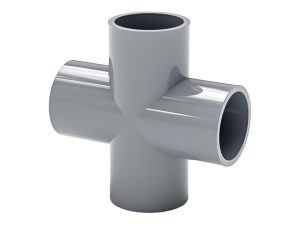Basic knowledge of PVC DWV system
PVC DWV (Drain-Waste-Vent) pipe fittings are core components of modern building drainage, sewage and ventilation systems. With its unique performance advantages, it has completely changed the traditional building drainage method. This type of pipe fittings is designed for non-pressure drainage systems and is essentially different from pressure pipe systems. The American ASTM D2665 standard clearly defines the size specifications and performance requirements of PVC DWV pipe fittings. The most common pipe diameters include 1¼ inches (32mm), 1½ inches (40mm), 2 inches (50mm), 3 inches (75mm) and 4 inches (110mm). These size designs fully consider the balance between drainage efficiency and space occupancy.
PVC DWV pipe fittings use a standardized color identification system. White or light gray is usually used in North America, while orange products are more common in the European market. This color coding system makes it easy for construction personnel to quickly identify the functional divisions of the system. In terms of materials, DWV pipe fittings are made of PVC Type I (12454) or Type II (14333) resin, with an impact strength of 10ft-lb/in² (ASTM D256) and a Vicat softening temperature of no less than 79°C (ASTM D1525). These parameters ensure the dimensional stability of the fittings in high-temperature drainage environments.

Product types and structural features
The PVC DWV pipe fittings family includes dozens of professionally designed product types, each targeting specific drainage function requirements:
Basic connection type:
90-degree elbow (conventional and long radius): hydraulic tests show that the long radius type can reduce drainage resistance by 35%
45-degree elbow: optimize drainage flow direction and reduce the probability of water jump
Tee (conventional and sanitary): sanitary design with 30° inclined branch pipe to avoid backflow
Four-way: modern buildings have restricted use because it is easy to cause drainage cross interference
Special function type:
P-type water trap: maintain a 5cm water seal depth to effectively block the lower Waterway gas
Combined floor drain: integrated hair filter (mesh ≤5mm) and deodorizing device
Vent valve: pressure balance accuracy of ±50Pa, replacing traditional roof vent pipe
Cleaning port: with threaded leak-proof cover design, easy system maintenance
Innovative structural design:
Silence tee: lined with porous sound-absorbing material (usually EPDM), noise reduction effect of 15dB
Expansion joint: maximum axial compensation of 50mm, solving the problem of building settlement
Anti-siphon pipe fittings: built-in one-way valve to prevent water seal from being damaged
These pipe fittings use a socket-type solvent connection system, combined with ASTM D2564 standard adhesive to form a molecular-level fusion joint. Experimental data show that the strength of a correctly constructed solvent connection can reach more than 85% of the strength of the pipe body. Modern DWV pipe fittings also generally use O-ring sealing design (in accordance with ASTM F477 standard), and the working pressure can reach 10psi (0.07MPa), far exceeding the actual drainage system requirements.

Performance advantages and technical parameters
PVC dwv fittings have multi-dimensional advantages over traditional cast iron pipe fittings:
Hydraulic performance:
The inner wall roughness coefficient is only 0.007 (0.015 for cast iron pipes), and the flow rate is increased by 40% under the same pipe diameter
The local resistance coefficient of the 90-degree elbow is 0.5, which is much lower than the 1.2 of cast iron pipes
The diameter retention rate is 100%, and there is no problem of pipe diameter reduction caused by rust
Physical properties:
Density 1.35-1.45g/cm³, which is only 1/5 of cast iron pipes, reducing structural loads
Thermal expansion coefficient 6×10⁻⁵/℃, an expansion ring is required every 3 meters
Combustion performance reaches UL94 V-0 level, oxygen index ≥45
Durability index:
Accelerated aging test (ASTM D794) shows that the performance decay is <15% in 50 years
Chemical resistance: It can withstand drainage environments with a pH value of 2-11
Antifreeze performance: It still maintains toughness at -20℃
It is particularly worth noting that modern PVC DWV pipe fittings use antibacterial modification technology to add silver ions or zinc ions (content 0.5-1.5%) to the surface of the product, reducing the attachment rate of microorganisms such as E. coli by more than 90%. The US IAMPO test shows that this antibacterial effect can last for more than 15 years.

Installation specifications and construction points
The correct installation of the PVC DWV system directly affects its performance and service life. The UPC (Uniform Plumbing Code) and IPC (International Plumbing Code) in the United States stipulate detailed technical requirements:
Support spacing standards:
| Pipe Diameter (inches) | Horizontal Support Spacing (m) | Vertical Support Spacing (m) |
| 1¼ – 2 | 0.8 | 1.5 |
| 3 – 4 | 1.0 | 2.0 |
| ≥ 5 | 1.2 | 2.5 |
Slope requirements:
Main drain pipe: 1/4 inch/foot (2% slope)
Branch drain pipe: 1/8 inch/foot (1% slope)
Long-distance pipes (>15 feet) require additional slope compensation
Solvent connection process:
The cut surface must be processed with a special chamfering device to produce a 15° bevel
The adhesive application time is controlled within 20 seconds
Curing time: 15 minutes for initial fixation, 2 hours to withstand water pressure, and 24 hours for complete curing
The design of the ventilation system is particularly critical. UPC stipulates:
Each drainage unit must be equipped with a vent pipe with a diameter of not less than 1½ inches
The vertical rise speed of the vent pipe should be <5m/s
The height of the vent pipe on the top floor of the building must exceed the roof by at least 15cm
For high-rise buildings, special attention should be paid to hydraulic impact protection:
Buffer elbows are set every 10 floors
Energy dissipation devices need to be installed at the bottom of the drainage riser
A double riser system should be used when the drainage volume exceeds 20L/s
According to the report of Global Market Insights, the global PVC The DWV pipe fittings market has reached $4.5 billion, with a CAGR of 5.8% expected from 2023 to 2032. The Asian market is growing fastest, with China accounting for 35% of global production capacity.






















